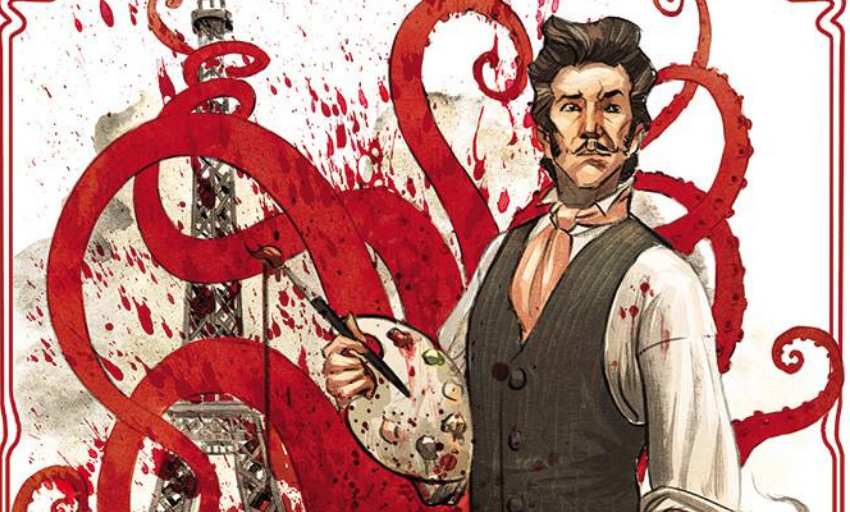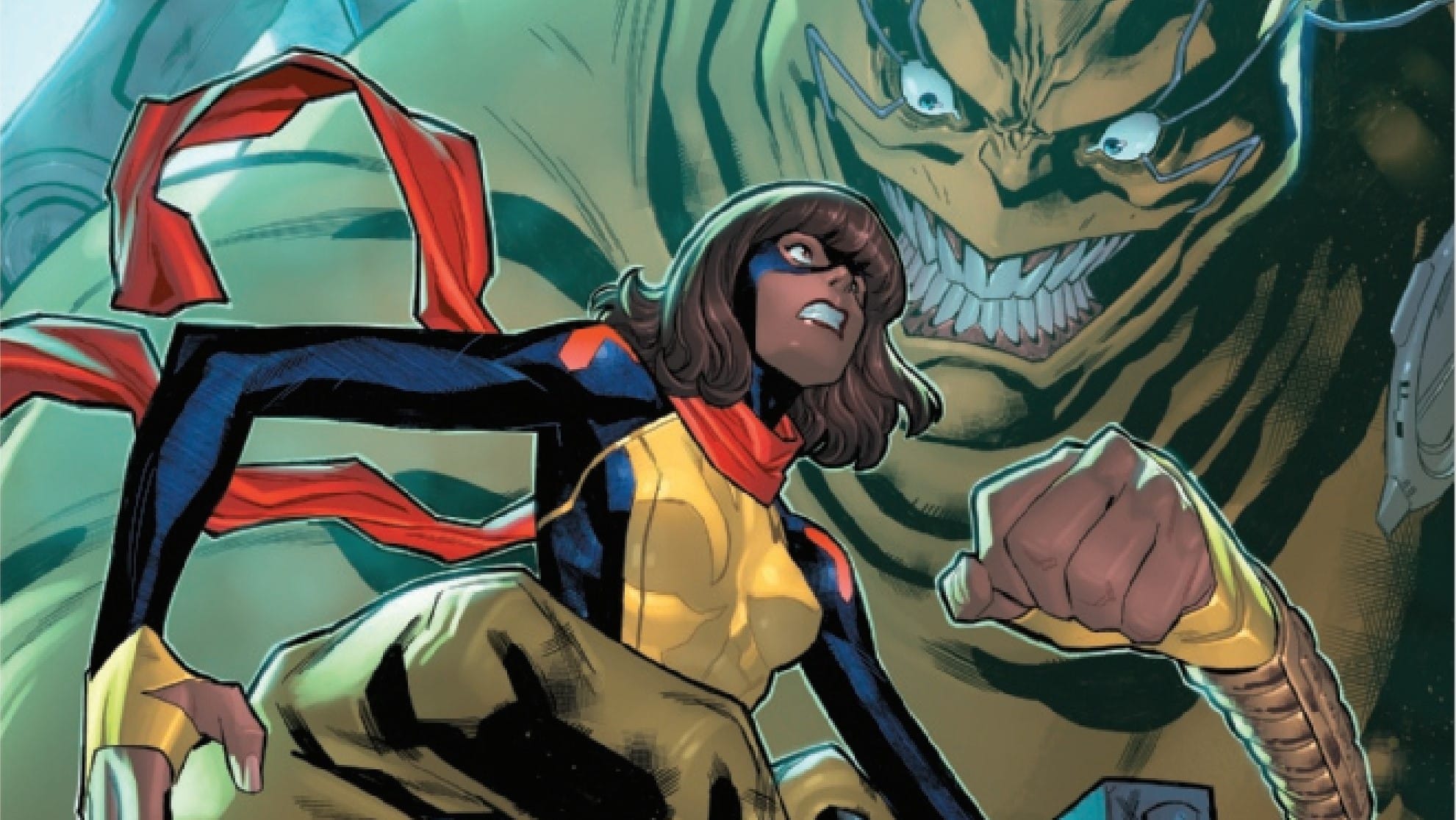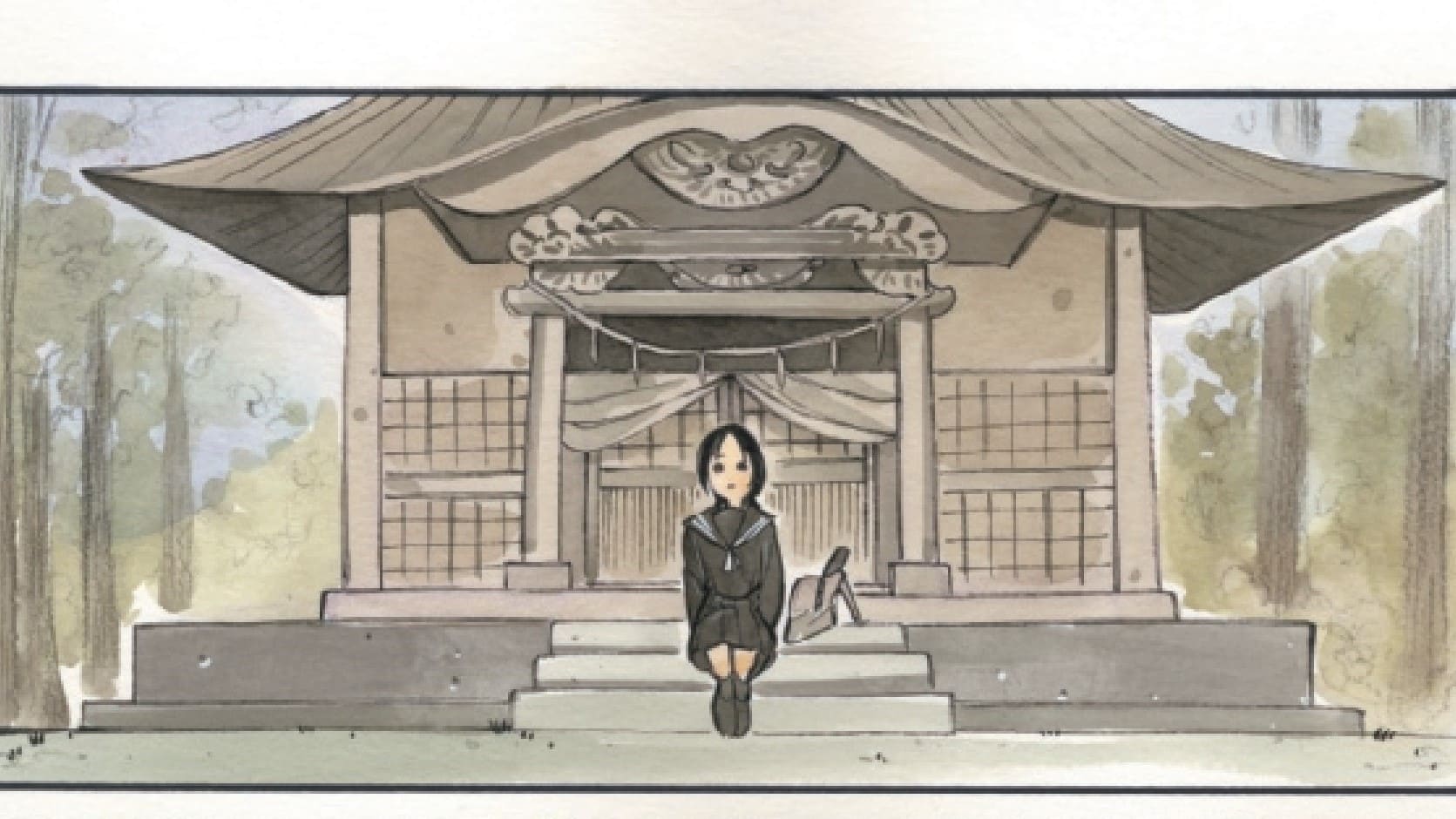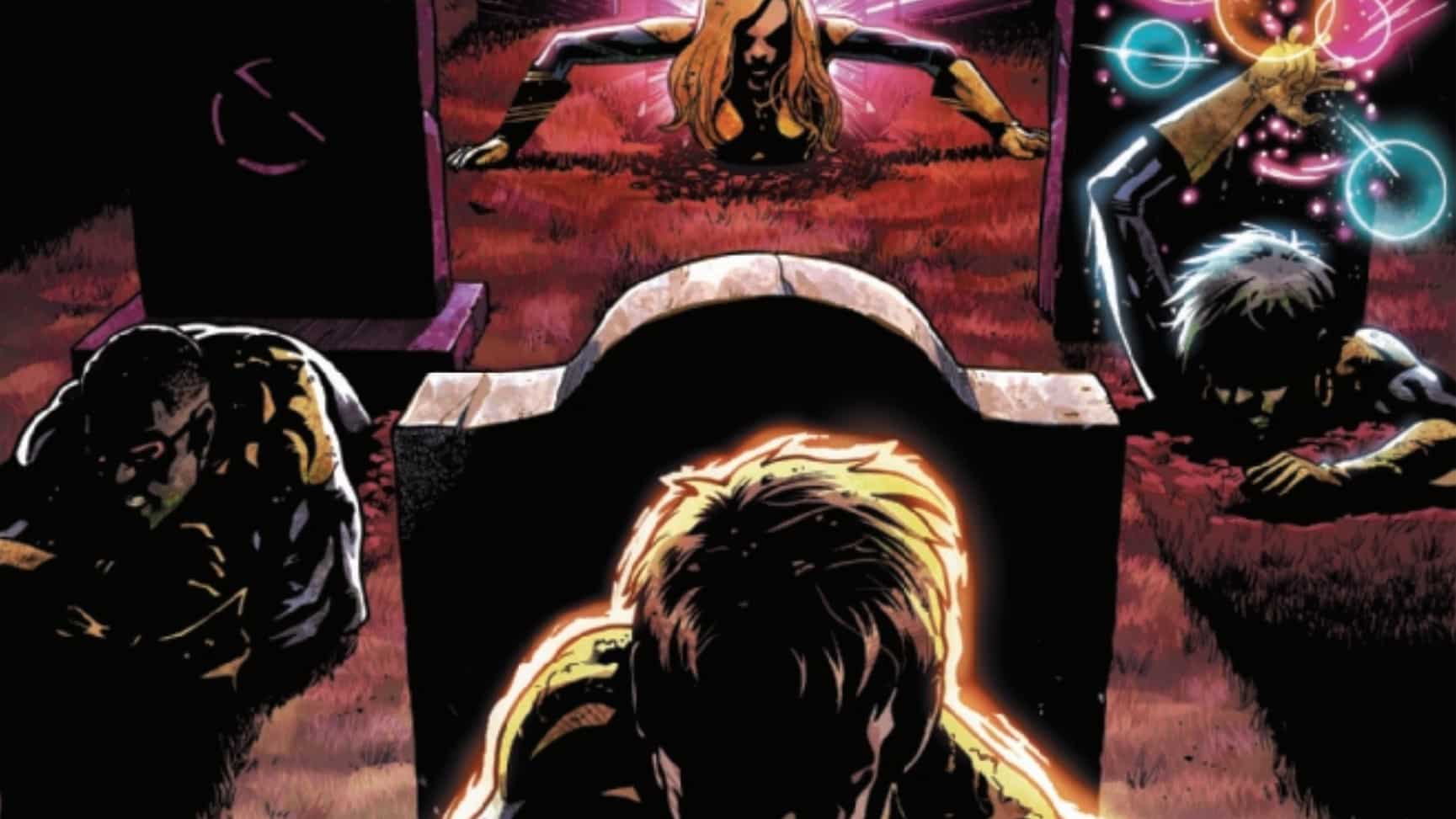As the new century dawns, former artist Marcel is in a better place. He is well regarded as a critic, in a relationship, and while he can’t paint, he seems to be content with that. But the return of his old friend Alphonse and Alphonse’s mentor, Basil Hallward, will change everything in Vault Comics’ The Picture of Everything Else #2 by Dan Watters, Kishore Mohan and Aditya Bidikar.
Matt Lazorwitz: While the first issue spotlighted a lot of the supernatural aspects of this series while working in plenty of character beats, this second issue is much more of a character piece. The supernatural stuff doesn’t even really come into play until the very end, which allows for some nice breathing room to further establish the character conflicts before next issue, when the supernatural nightmares look to be hitting the proverbial fan.
Ari Bard: Definitely. The Picture of Everything Else #2 really connects the world back to Oscar Wilde’s original work and makes it clear that the story is beyond just taking place within the world of a classic. Here we’re able to dive into the motivations behind art, the cost that art demands, how art interacts with the world around us, and the relationship between criticism and art. It’s a lot to cover, but the issue does it well, so let’s dive in.
‘None of them understand how hard it is to bleed for one’s art.’

AB: A big theme in The Picture of Everything Else #2 deals with the toll that art can take on an individual, whether it be physical or emotional. The Alphonse and Marcel who used to paint because they loved it and because they saw beauty in doing so are no more. Now we have an Alphonse who only creates in order to change, and a Marcel who can no longer do so because of debilitating migraines whenever he tries to paint. For Alphonse and Marcel, art continues to have no morality, but art definitely has an impact. Can both really be the case?
ML: I think Marcel is struggling with this. The migraines read as a reaction to the death and horror he has seen the art of painting can do when wielded by the likes of Hallward. He can’t bring himself to paint because under his callous view of art, put forth to Madame Verniere and to Picasso, he is struggling to understand how something that for him was once a font of beauty is now something he knows can destroy.
Meanwhile, we have Hallward, seemingly immortal but not invulnerable. Almost relishing the pain left by the scars that Dorian Gray left him with. For him, the art has always hurt, and he revels in it. There is almost a metaphor for birth in it: From pain comes beauty. And Hallward, despite his amorality and inflicting of suffering, still seems to see beauty in his painting.
AB: That’s interesting because I think Basil’s attitude toward his painting has become something much more primal and physical. The scars Dorian Gray left him with are located on his heart, but very little about Basil’s art appears to grasp at emotional significance. There’s so much physicality in Basil’s scenes and in the issue in general. Art wounds and ruins in very literal ways, but Basil, perhaps because he is so used to affecting reality with his work, now fails to realize art that thrives in metaphor or in the unspoken. There’s a lot lost with the power he now wields, and it leaves you wondering whether the artist died when the monster was born.
‘A calling … towards a new French Modernism’

AB: Watters makes a lot of commentary through the context of French Modernism moving forward from the works of neoclassicism, but he’s really contemplating what it means to push the boundaries of a medium forward and whether one can truly make a breakthrough while holding onto the past. We would be remiss if we didn’t discuss how this relates to the comic book medium today and how so many creators are still so hung up on works such as Watchmen and formalist practices like the nine-panel grid. Watters is probably saying something about the very medium he’s writing here, and it’s interesting that he’s doing so while playing in a world from the past. Nevertheless, we rarely see styles or techniques pulled from other mediums, so in the world of comics, this may very well be pushing the medium forward. Marcel appears to despise the reactionary but also cannot answer Madam Verniere’s question, “How might it move forward without considering what came before it?” It’s likely a debate that will persist without end, and Marcel moving on is enough of a response in itself.
ML: You’re definitely right when it comes to the discourse on comics. I don’t know what work will redefine comics as we know them; maybe the creator who is going to do it is working now and just hasn’t come up with that piece of art yet, but things still seem to be reacting to 1985, no matter how hard we try to move away from it.
I’m not an artist, and my grasp of art and coloring is not the strongest, but this book definitely feels like it’s trying to be something different. The panel layouts here aren’t something like you’d see from Bill Sienkewicz or J.H. Williams III when he’s being very experimental, but this book really knows what it’s doing when it comes to panel layout. It uses the nine-panel grid in a couple of places to really amp up the tension and drag out a moment, and it uses bigger panels and splashes to show quicker movement of time. It’s craftsman’s work.
Kishore Mohan, who both draws and colors the book, is definitely doing something outside the norm of what we see in comics with his coloring. Is it just me, or do the colors for this book give the impression of watercolors to you, Ari?
AB: I definitely think you’re right, Matt, and I also think the art in this book is meant to invoke the period it’s talking about. The lines and watercolors render almost to create a biopic in comic form. The attention to lighting in this issue is particularly noteworthy. Certain panels glow with a luminescence as close to natural sunlight as you can get but then quickly fade to cool blue-gray shadows. Each panel is its own little painting.
I think this creative team is striking a remarkable balance here and demonstrating how the past doesn’t have to be completely ignored in order to be left behind. This team uses every tool in the book, whether it be invoking the nine-panel grid, drawing on a famous work of literature, formalism and elements of prose, but it never relies on them. They are simply tools or brushstrokes that are irrelevant on their own in a larger painting.
The Critic as Artist

ML: Before we get into this issue’s specific takes on criticism as art, it is important to note that one of Wilde’s most famous essays is titled, as this section is, “The Critic as Artist.” It says that only through engaging in his own critical thinking can an artist first attempt creation of art, while the critic exists outside the artistic work he is criticizing.
AB: The creative team was certainly not afraid to get contemplative in this issue and strike at criticism in all its beauty, frustration and necessity. It’s quite amusing that the artist Marcel noticeably critiques in this issue is Picasso, and how dare anyone criticize a true artist like that. There are many gut punches at the heart of critics and artists alike in this issue, which leaves us a lot to talk about.
ML: Most definitely. Watters did his research here, too, as Picasso was in Paris between 1900 and 1901, where he fed his paintings to the fire to keep warm (at least according to the ever reliable Wikipedia). I have to admit, seeing Picasso repeatedly pull a gun on Marcel because of his anger at Marcel’s criticism seems like only a few steps further than the kind of responses some creators in many artistic fields seem to give over social media these days. But that may just be me being cynical.
I’ve always wondered about Wilde’s statement about the critic existing outside the art, though. To me, the purpose of art is to envelope and move the viewer and the critic, and if it isn’t making you a part of it, to me it’s missing something. But I also try never to think of myself as a critic, but as a person who enjoys art and likes to talk about it, to try to keep the cynicism that often comes with being “a critic” at bay for one more day.
AB: I think your cynicism is definitely warranted, but it’s also quite difficult for me to define the purpose of art because so many purposes are valid. I’m not sure an audience can be a part of that definition, however, because the artist only has so much control over the feelings of the viewer or critic, and art created only for the artist is still considered art and can still have an effect on others. So perhaps I agree with Wilde’s statement in that criticism exists outside the art to where it should not affect the creation of art. Art should not consider what the critic will say before the piece is done. At the same time, some of my favorite criticism is completely enveloped within the art. It manipulates art freely, lives inside it, tears it apart and puts it back together to create a new work of art in itself. Sometimes I hope what I write can be considered criticism on that level, and other times I’m OK if it can’t. I wish Watters would have spent a little more time with Marcel as a critic, however, because his few remarks are very vague, abstract and always regard the entire medium, which is rarely how criticism manifests.
Miscellany
- Bits of this story are set at the legendary Parisian cabaret the Moulin Rouge. Famously associated with the Moulin Rouge is legendary French painter Henri de Toulouse-Lautrec, who when he traveled to London befriended, and painted, a famous portrait of Oscar Wilde. This is one of the great things about historical fiction; the little connections that can be drawn and created between the fiction and the reality.







